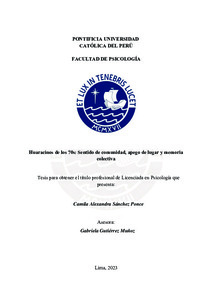Huaracinos de los 70s: Sentido de comunidad, apego de lugar y memoria colectiva
Abstract
El 31 de mayo de 1970 ocurrió un terremoto de gran magnitud en la zona sierra del
Perú, Huaraz. Si bien esa fecha actualmente se recuerda a través de una ceremonia, las y los
sobrevivientes del terremoto no olvidan lo que fue “un quiebre en sus vidas”. En este sentido,
la comunidad virtual “Huaracinos de los 70s” ha representado un medio para poder preservar
la memoria colectiva de dicho evento. En éste, las consecuencias que recuerdan del terremoto
son diversas, pues los llevaron a caminos que no pensaron recorrer y, en algunos casos, los
alejaron de su ciudad. La presente investigación busca comprender el sentido de comunidad y
apego de lugar en un grupo de sobrevivientes del terremoto de 1970 en Huaraz, a partir de la
memoria colectiva, a través de la epistemología socio construccionista. Para ello, se realizaron
dos grupos de entrevistas participativas a sobrevivientes miembros de la comunidad virtual
previamente mencionada. Los resultados muestran que el sentido de comunidad se ha visto
potenciado a través de la identificación con la comunidad virtual y la conexión emocional
compartida entre sus miembros. Además, existe una fuerte cercanía afectiva con la ciudad, a la
que recurren para actividades colectivas y personales, demostrando que, a pesar de encontrar
un Huaraz transformado, aún existe un apego a dicho lugar. De esta manera, incluso 53 años
después del desastre, tanto el sentido de comunidad como el apego de lugar hacia Huaraz se
refuerzan por la historia en común, fortaleciéndose la memoria colectiva. On May 31, 1970, a large earthquake occurred in the mountainous area of Peru, Huaraz.
Although that date is currently remembered through a ceremony, the survivors of the
earthquake do not forget what was “a break in their lives.” In this sense, the virtual community
“Huaracinos of the 70s” has represented a means to preserve the collective memory of said
event. In this case, the consequences that they remember from the earthquake are diverse, since
they took them down paths that they did not think to take and, in some cases, they took them
away from their city. The present research seeks to understand the sense of community and
place attachment in a group of survivors of the 1970 earthquake in Huaraz, based on collective
memory, through socio-constructionist epistemology. To this end, two groups of participatory
interviews were carried out with survivor members of the previously mentioned virtual
community. The results show that the sense of community has been enhanced through
identification with the virtual community and the emotional connection shared between its
members. Furthermore, there is a strong emotional closeness to the city, which they resort to
for collective and personal activities, demonstrating that, despite finding a transformed Huaraz,
there is still an attachment to said place. In this way, even 53 years after the disaster, both the
sense of community and the attachment to Huaraz are reinforced by their common history,
strengthening collective memory.
Temas
Psicología comunitaria--Perú--Estudio de casos
Memoria colectiva--Perú
Desastres naturales--Perú--Huaraz (Ancash : Provincia)
Apego
Memoria colectiva--Perú
Desastres naturales--Perú--Huaraz (Ancash : Provincia)
Apego
Para optar el título de
Licenciado en Psicología
Collections
The following license files are associated with this item:






